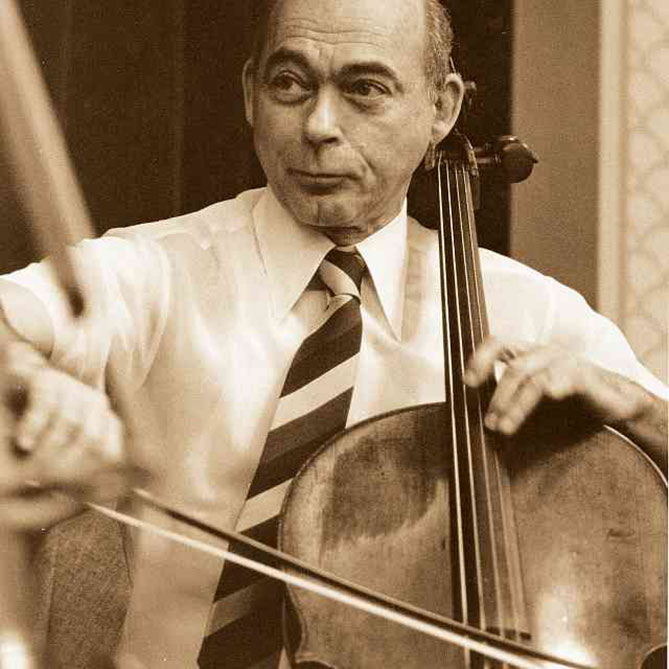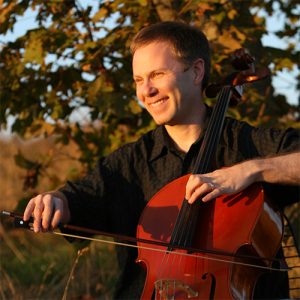
Master Class Report: János Starker 2/29/01
Tim Janof
Benaroya Hall, Seattle, USA, 2/29/01
The following are my notes from the master class Janos Starker gave in Seattle. 10 minutes before the class was to start, Seattle experienced a 6.8 earthquake. Apparently, Janos Starker was calm as can be backstage when it happened. The class ended up starting only 1/2 hour late. —by Tim Janoff
- Anticipated Shift — Slide before the bow change and land on the note at the bow change.
- Delayed Shift — Slide after the bow change.
- Thumb Placement in Thumb Position — A hitchhiking thumb allows more overtones, but it is harder to play in tune. Placing the thumb on the neighboring string is more solid, but it allows fewer overtones. The technique of the future is to place the thumb beneath the fingerboard.
- Don’t squeeze with the thumb.
- Practice double-stops, not just single notes. This will help you play more in tune and help to familiarize you with the fingerboard.
- You need a more fleshy contact with your fingers when you play on the C string.
- The fingers should be curved at all times, even in thumb position. Your intonation is better, you have a natural finger motion that is comprised of momentary tension and release, and you have clearer articulation.
- Before starting chords be sure to bend your right thumb. They will come out less crunchy.
- Plan the speed of your bow before you begin your bow stroke.
- Feel your arm weight as you start your bow stroke.
- Play with as much bow as you need, but no more than that.
- On fast separate notes, use your whole arm to shake your wrist. Don’t just use your wrist.
- Use arm weight when you bow, which means that your arms can’t be too high.
- “If you are not using your whole bow, then why don’t you chop off the end?” — Rostropovich.
- Dip the elbow before you begin a down bow at the frog. The lift your elbow up and you approach the tip.
- The “peanut butter theory” — Play with a slow brushing, as if you are spreading peanut butter.
- Don’t hold your pinkie finger on the frog as you play in the second half. Allow the rotation of your forearm.
- Your bow hold should adjust depending on where you are on the bow. Have a flexible bow hold.
- If you are tall, you may want to try a higher chair, sit back in the chair you have, or perhaps try a bent endpin.
- All joints shall be curved.
- Keep the body position as flexible as possible. Don’t sit as if you are cast in concrete.
- Lift your arms from your back muscles. Imagine you are butterfly, or you are doing the butterfly stroke.
- When tuning to a piano, tune to the note after the initial impact of the piano key. The piano’s note rises after the initial strike.
- In order to help maintain your sound as you reach the tip of the bow, use counter-pressure with your legs. For instance, when you play on the D string, press against the cello with your left knee. When you play on the C string, press against the cello with your right knee.
- Move the cello to a position that allows you to reach your notes most efficiently. For instance, when you are playing on the A string, lean or rotate the cello to the right.
- There should be air between all of your fingers in both hands, i.e. your fingers should not be squeezed together.
- “Suspended sound” — suspend the bow with the second finger and don’t play so “in the string.”
- Take more time when you have larger intervals. Be sure to make up the lost time afterwards, however.
- In the Adagio of the Dvorak Concerto, keep it moving along. Don’t let the movement die with pauses that are too long.
- You know you are in trouble as a performer when the crowd, not only looks at their watches, but shakes them too to makes sure that they still work.
- When you play as if you have fallen in love with a certain note, it’s like falling in love with a girl because she has a nice nose. Don’t lose sight of the larger phrase by indulging in individual notes.
Subjects: Artists
